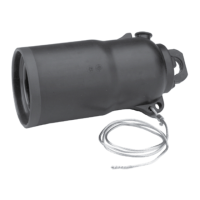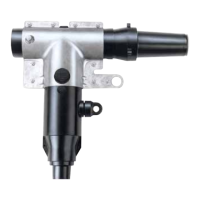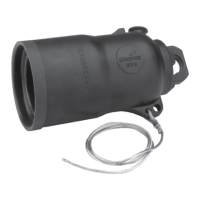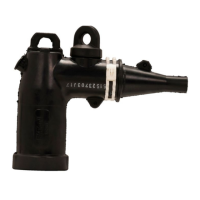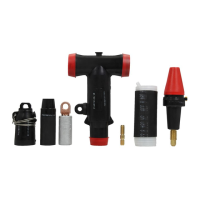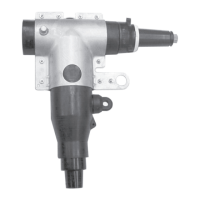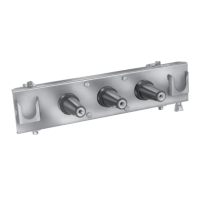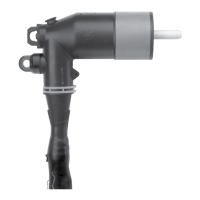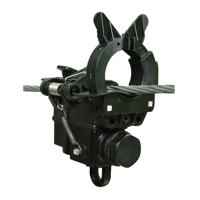4OPERATING INSTRUCTIONS MN280067EN July 2017
Type MET electronic recloser control tester operating instructions
Tester
Test Selector switch (S6) in BATT. VOLTS—40V; Power switch
(S1) OFF; power cord plugged into outlet (see CAUTION at
beginning of OPERATING PROCEDURES section).
Battery voltage
1. Plug the battery test cable, furnished with the tester,
into the BATT. TEST terminals on the tester and the
battery terminals on the control.
ote:N The spacing between the battery test-terminal
posts on the tester is intentionally staggered to
assure proper connection of the test cable plug.
Make sure all three pins on the plug are properly
seated in the three terminal posts.
The bar extension on the side of the plug at the other
end of the battery test cable assures proper connection
of the cable to the three-battery test-terminal posts
on the electronic control. If the control is equipped
with only two terminal posts, plug in the test cable
with the two pins farthest from the bar extension
engaged(Figure 3).
2. Read the open circuit voltage of the battery on the
dc meter. A fully charged Form 2, Form 3 or Form 3A
battery will normally read 26—28 volts.
3. Depress Battery Load Test switch (S7) for about two
seconds (or just long enough to read the meter). For a
fully charged Form 2, Form 3 or Form 3A battery, the
voltage should not drop more than 3 volts from the
open circuit voltage. (Typical drop will be 1.5 to 2 volts).
BAR
EXTENSION
ON PLUG
TEST
TERMINAL POSTS
ON CONTROL PANE
BATTERY
LOCKOUT
INDICATOR
CONNECT THESE TWO
PINS TO THE TERMINAL POSTS
BATTERY TEST
CABLE PLU
G
Figure 2. Battery-test cable connections to control with
only two battery-test terminal posts
Battery discharge and charge rates
The MET tester can be used to measure battery discharge and
charge rates on Form 2, Form 3 and Form 3A controls only.
1. Connect the control to the tester with the proper test
cable and energize the tester ON-OFF switch S1 to
ON. Disconnect the jumper between the current (⇐|⇒)
terminals on controls equipped with three test terminals.
2. Move the manual control switch on the electronic
control panel to CLOSE and release. The target above
the switch will show red.
3. Turn Test Selector Switch S6 to DISCHARGE—(4 MA)
and measure the battery drain. Normal quiescent battery
drain measures 1.5 to 2.0 mA. Certain accessories can
increase this nominal value above 4 mA. (See Table 2
inAppendix A).
ote:N The 15-mA charging rate specified in Steps 4A,
4B, and 4C is a nominal value based on a 27-volt
battery and rated input parameters (e.g. 120 or
240 Vac with potential chargers or 40- amp line
current with recloser CT charger). Even under
these standard conditions, a variation of ±2 mA
may be observed in the charging rate.
4.
A. If the electronic control is equipped with a 115-Vac
battery charger, turn Test Selector Switch S6 to
CHARGE— (40 MA) and energize the charger circuit.
The charging rate should be approximately 15 mA
minus the discharge rate measured in Step 3.
B. If power for the battery charger is supplied by a
bushingcurrent transformer on the recloser (Type
RE and WE reclosers) the following procedure may
be used to check the charging rate.
ote:N A minimum of 40 amps line current through
Phase B of the recloser is required to power
the battery charger. This may be obtained
from normal line-current flow through an
on-line recloser, or in the case of a recloser
removed from service, by manually closing
the recloser and applying a low-voltage,
highcurrent ac power supply across Phase B.
(1) Using the interconnecting cables supplied with
the tester, connect both the control and recloser
to the appropriate receptacles on the tester.
ote:N The elbow plug of both test cables is
connected to the tester.
(2) With the recloser closed and a minimum of
40 amps flowing through Phase B, turn Test
Selector Switch S6 to CHARGE—(40 MA). The
meter should read approximately 15 mA minus
the discharge rate measured in Step 3.
C. If power for the battery charger is supplied from
a 230- Vac source in the operator cabinet of the
motor driven reclosers, proceed as follows:
(1) Using the interconnecting cables supplied with the
tester, connect both the control and the recloser to
the appropriate receptacles on the tester.

